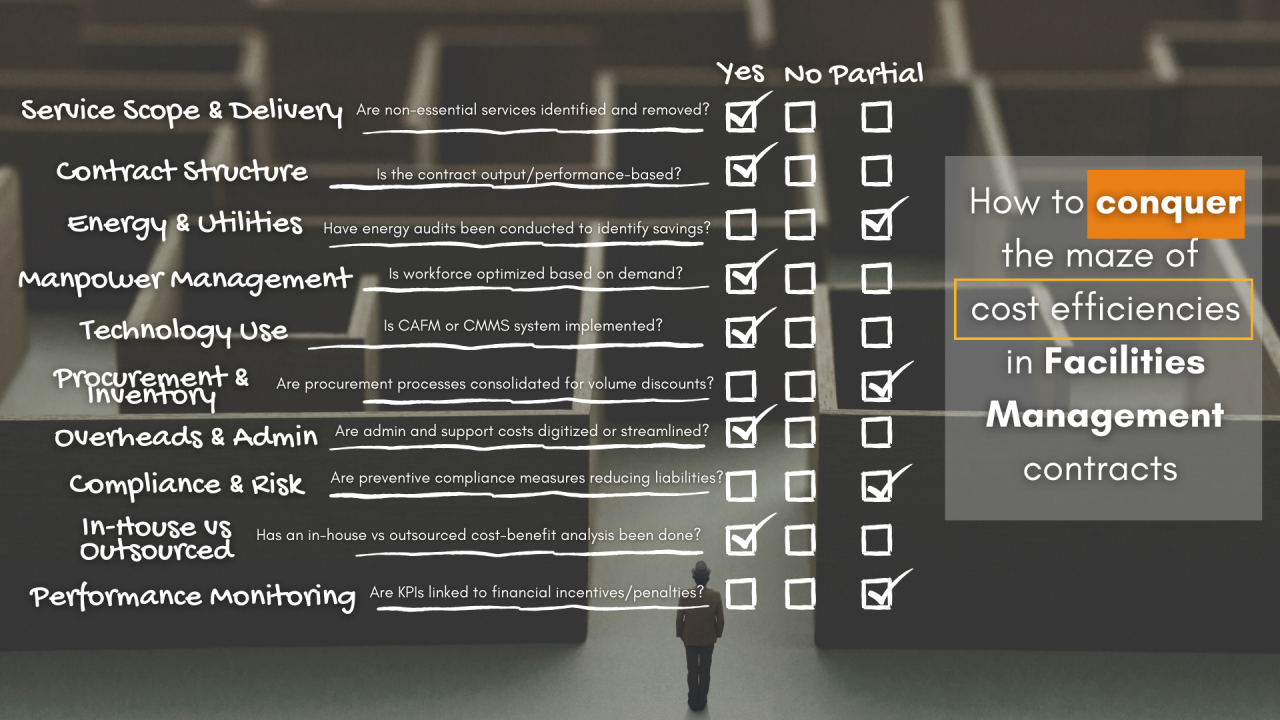In the backdrop of the competitive landscape and client pressure to cut costs, this is the first and last resort to upend the bottom line.
Identifying cost efficiencies in facilities management is on the mind of every FM operator. In the backdrop of a gruelling competitive landscape, coupled with clients’ demand to drop margins that are cutting corners on all cost fronts, finding a silver lining on profit margins is daunting. It is becoming a herculean task for facilities management companies to navigate this maze.
It becomes more challenging when there is a free fall in bidding margins; hence, pruning the cost of sales and its related overheads is imperative. This requires a strategic review of both contractual provisions and operational practices.
At EFS, having found ourselves knee-deep in such a situation, we adopted a structured approach to identify high-impact areas where cost efficiencies could be achieved:
Service Scope Rationalization
By reviewing the scope of work across the contracts to determine whether they are delivering the necessary output. This ensured the elimination of redundant or non-essential services, especially in the case of hard services, by moving from preventative to the predictive maintenance regime and in soft services by assessing daily deep cleaning tasks in low-traffic areas or revising the frequency and nature of the tasks as needed.
By delving deeper into other Service Level Agreements (SLAs), the areas to adjust schedules can be identified without impacting the SLAs.
Bundle Services
Integrating soft and hard services under a single contract reduces administrative and vendor management costs. By merging certain roles, for instance, replacing electrical or mechanical technicians with multi-skilled MEP technicians, the cost decreases and overall effectiveness is improved.
This role rationalization approach can be applied across various disciplines, from audio-visual to information and communication technology (ICT), where roles can be merged.
Building a Shared Services Model
For multi-tenant sites or business clusters, sharing FM personnel from management, administration and supervision across various teams including security, landscaping and maintenance teams, can create an efficient shared services model. This approach ensures lean and agile overheads while reducing overall project costs.
Output-Based Contracting
Engage and encourage clients to shift from input-based (manpower hours) to output or performance-based contracts where payment is tied to service outcomes, such as cleaning services adjusted to occupancy levels and HVAC services based on footfall traffic, occupancy, and seasonal demand rather than fixed schedules.
Moving away from frequency-based monitoring towards technology-based surveillance in security services may allow for less frequent checks. Herein, the objective is to achieve effective SLAs with better productivity.
Energy and Utility Optimization
Utility costs constitute a significant portion of overall building management expenses, making FM a vital player in controlling these costs. Therefore, energy audits and retrofits can help deliver results.
Also, by upending asset conditional assessments and implementing an effective building lifecycle management, one can identify the right maintenance and energy regime that helps reduce both operating expenses (opex) and capital expenditures (capex). Strategies may include installing LED lighting, occupancy sensors, and Building Management Systems (BMS) for HVAC systems.
Additionally, water efficiency and conservation methods, such as using low-flow fixtures and early leak detection, can be implemented. Likely use of renewable energy sources such as solar panels or greywater systems for long-term savings can also be explored.
Manpower and Resource Optimization
Staff performance can be enhanced by conducting productivity purges based on peak and off-peak demand analytics, as well as studying time spent on specific tasks. Cross-training technicians to be multi-skilled helps reduce the overall headcount.
Automated scheduling through Computer-Aided Facility Management (CAFM) systems can be utilized to streamline manpower deployment. Elements such as overtime, reliever management and absenteeism need close monitoring to bring efficiencies.
Technology Integration
Effective Implementation of CAFM and available IT tools facilitate the adoption of a data-driven approach, such as predictive maintenance to foresee failures. Asset life is tracked to optimize maintenance schedules, remote monitoring is enabled to reduce the need for manual inspections and live dashboards are used to monitor and analyze tasks and project schedules.
